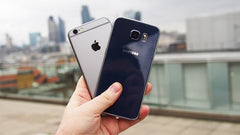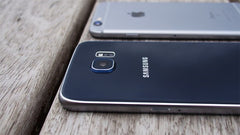Android vs. iOS, Apple vs. Samsung, iPhone 6S vs. Samsung Galaxy S6
May 18, 2016 • Android • Apple • iPhone • Reviews • Samsung
The Samsung S6 and iPhone 6s comparison
Many if not all would argue that iPhone 6S and Samsung Galaxy S6 are the best smartphone flagships of 2015. Now that the year is ending, we had plenty of chances to actually use them and thus issue a trustworthy comment on these gadgets. A lot of end users would claim that it’s all about your personal preferences as to the operating system. That sounds true, but we still want to dig into the main features and their advantages/disadvantages.

Design
Galaxy S6: 6.9mm thick, aluminium unibody and glass panel
iPhone 6S: 7.1mm thick, Series 7000 anodised aluminium back
From the first sight iPhone 6S can seem much alike its predecessor though it’s not completely accurate. In the newcomer Apple has switched to the Series 7000 aluminium. This is the material it uses for Apple Watch and it provides for a sturdier device. It’s 60 percent stronger than standard aluminium, but just as light. Also it came to be just a little (2mm) thicker and that’s due to some new great features.
Samsung instead has gone with a strikingly shimmery glass back and a distinctively molded metallic edge with Galaxy S6. It does make the device extremely eye-catching and very elegant. However, once you consider the practical side, you will definitely come to realize the glass is exactly something that makes the gadget more slippery. So you end up with a device that is more likely to fall out of your hands, slide off a slightly unbalanced surface and the fingerprints are more visible on it as well.
So in terms or practical day-to-day use the iPhone is a winner in our opinion. Its all-metal construction combined with a little smaller size simply make it handier.
Screen
Galaxy S6: 5.1-inch, 2440 x 1560 'QHD' Super AMOLED
iPhone 6S: 4.7-inch, 1334 x 750 IPS LCD, 3D Touch
We do enjoy iPhone’s display, which is perfectly sized for one-handed usage, 1334 x 750 resolution is just sharp enough being also extremely bright and vivid. And while that’s pretty much what iPhone 6 had, the new 3D Touch feature does make for an improvement. This new technology recognizes the amount of pressure you place on the display, literally enabling an extra layer of depth to touch inputs.
The Galaxy S6 doesn’t have the 3D feature, but its QHD resolution is much sharper than what iPhone offers. Its Super AMOLED technology provides for a lot more vibrant colors with deeper blacks and higher contrast. To put it simply, the iPhone 6S display is smarter, but the Samsung Galaxy S6 screen is far better looking.
Camera
Galaxy S6: 16-megapixel rear camera, f/1.9 aperture single LED flash, OIS, 4K video recording
iPhone 6S: 12-megapixel rear camera, f/2.2 aperture, dual LED flash, 4K video recording
Apple has delivered an upgrade camera-wise in iPhone 6S with a new 12-megapixel image sensor. Up front is a 5-megapixel Retina HD with Retina flash that uses the entire phone screen to capture your mug. There is one disappointment about it though as there is shot-steadying technology that could have improved its low-light shooting experience. Obviously, that’s due to the thinner model size.
While Galaxy S6 has it all. The 16mp camera, optical image stabilization are not the only advantages. Home button-based camera shortcut makes taking a shot very fast, and a great Pro manual mode gives you a variety of options to enjoy. Galaxy S6 also has a wider aperture f/1.9 lens than the f/2.2 iPhone 6S, which lets more light in and helps with both low-light shots and revealing the background in amazing way.

Power
Galaxy S6: Exynos 7420 64-bit octa-core, 3GB RAM
iPhone 6S: Apple A9 64-bit dual-core CPU, 2GB RAM
iPhone 6S is designed with the brand new Apple A9 processor, designed to be 70% faster at CPU tasks and 90% faster at graphics than the A8 chip in the iPhone 6. It's an impressive set up and beats the iPhone 6 at multitasking.
Galaxy S6 came along with Samsung's own Exynos 7420, an octa-core chip that blitzed the A8 on multi-core performance and got surprisingly close on single-core terms.
Things get interesting when we turn to RAM. The Galaxy S6 has a generous 3GB, while the iPhone 6S has 2GB of RAM.
Software
Galaxy S6: Android 5.1 Lollipop with TouchWiz UI
iPhone 6S: iOS 9
The iPhone 6S ships with iOS 9, which includes improvements to Siri, long awaited Apple Maps features and more, plus all the slick intuitiveness of its predecessor, iOS 8. There a few design tweaks but don't expect the overhaul we got last year, much of it looks and feels the same - just a few minor improvements around the edges.
The Galaxy S6 runs Android 5.1, overlaid with TouchWiz. Samsung's TouchWiz UI has been divisive over the years, but it's at its best here.
To us it’s all about which OS you are used to and what your personal preferences are. But it's still undeniable that the App Store is a more vibrant, higher quality offering than the Google Play Store.
Battery
Galaxy S6: 2550 mAh
iPhone 6S: 1715 mAh
We’d say the battery is one of the weakest features Galaxy S6 has. It is smaller than the one of its predecessor and will definitely not last more than a day between your regular charges.
Unsurprisingly, iPhone 6S has exactly the same problem, where you might not even be able to last a day on the battery without recharging it.
To make our arguments more practical, we ran a 90 minutes video on both gadgets with screens on full brightness and with Wi-Fi in the background. The iPhone 6S declined from 100% to 70%, which is rather disappointing. While Galaxy S6 dropped just 16% in the same test - and that's with a larger, higher resolution display.
We have to admit that both Samsung and Apple have crafted great devices. As all gadgets they have few weaknesses, but those are pretty minor and if used in a smart way, you will not be experiencing those. The real choice between them is iOS or Android, because in most ways they seem similarly accomplished. When you really take a thorough look at the different platforms you realize both can do very similar things and it's more a case of personal taste.
